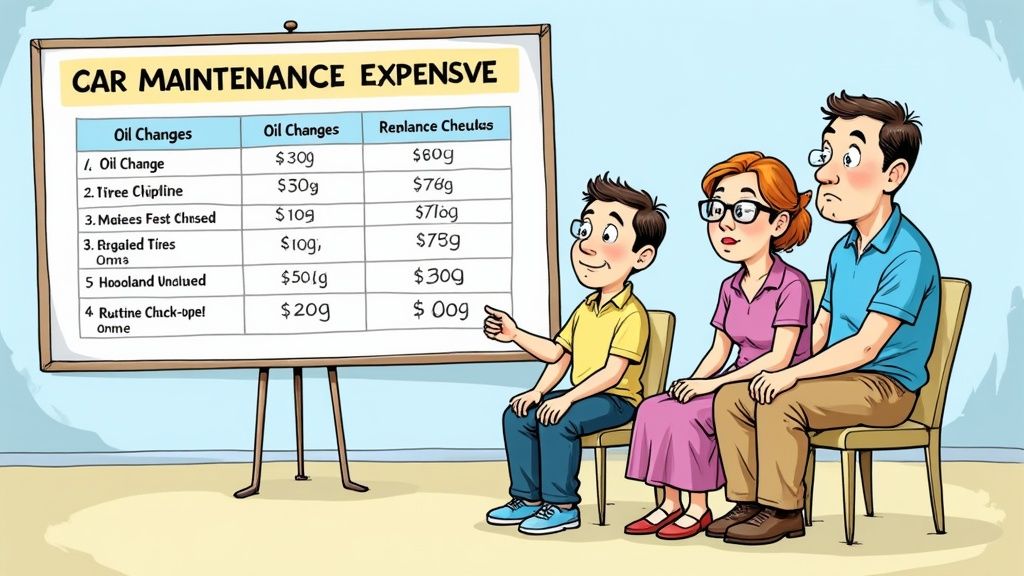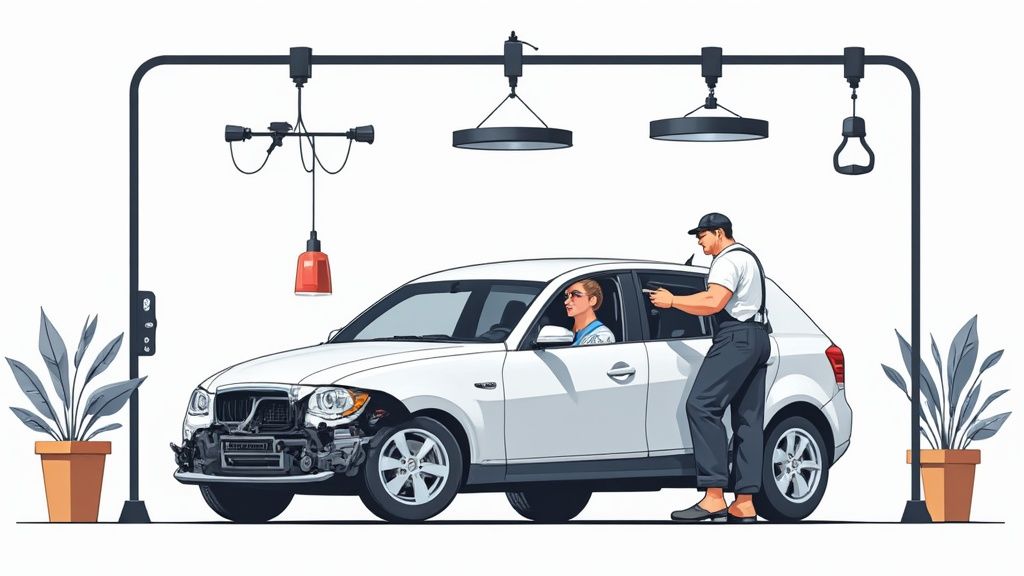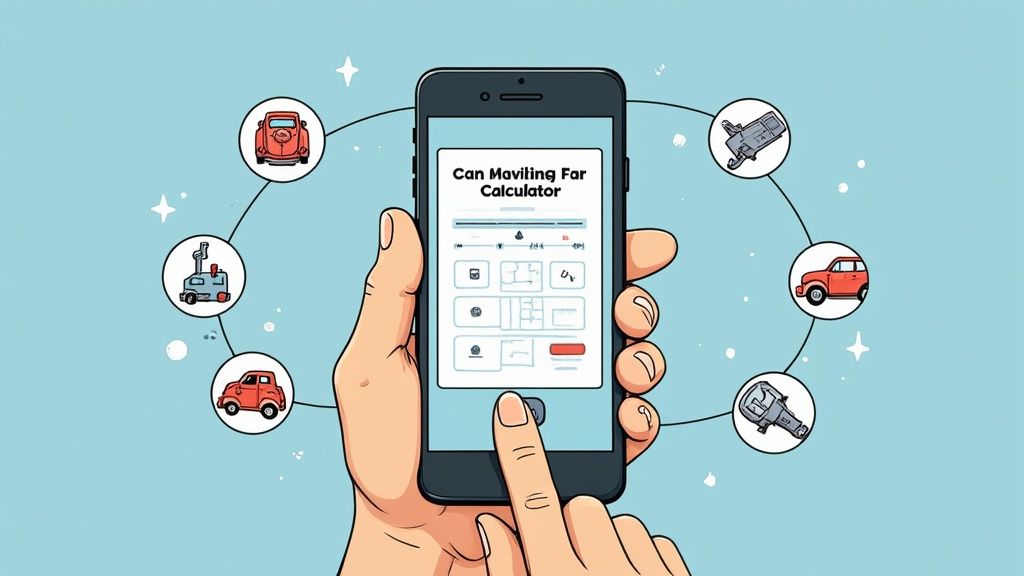
Ultimate Guide to Average Car Maintenance Costs: What to Expect and How to Plan
Understanding Essential Car Maintenance Costs

When you buy a car, the price tag is just the beginning. Regular maintenance is crucial for keeping your vehicle running properly and avoiding major repairs down the road. Just like you need regular health checkups, your car requires ongoing care and attention to stay in good shape.
Routine Maintenance: The Foundation of Car Care
Taking care of basic maintenance tasks helps catch problems early before they become serious issues. Key services include oil changes, tire rotations, and multi-point inspections. Regular oil changes protect your engine by providing proper lubrication, while tire rotations help your tires wear evenly and maintain good handling. These simple services go a long way in extending your car’s life.
The True Cost of Routine Upkeep
Basic maintenance costs may seem small individually but add up throughout the year. According to the American Automobile Association (AAA), car owners spend an average of $800 annually on maintenance, or about $66 per month. A typical oil change runs between $35 and $125, and tire rotations cost $20 to $100. While these expenses are necessary, they help prevent much costlier repairs later on. For more details on typical repair costs, check out this helpful guide.
Unexpected Repairs: Budgeting for the Unforeseen
Even with regular maintenance, surprise repairs can happen. These range from minor issues like replacing a battery to major problems with engines or transmissions. The typical cost for unexpected repairs falls between $500 and $600, though major fixes can exceed $10,000. Setting aside money specifically for car repairs provides peace of mind, similar to having an insurance policy.
Tracking and Managing Your Maintenance Budget
Keeping detailed records of your car expenses helps you plan and budget effectively. Tools like Auto Service Logger make it easy to track all maintenance and repair costs in one place. This gives you a clear picture of your spending and helps you anticipate future expenses. For example, knowing the typical cost of tire rotations allows you to budget accordingly.
Smart car maintenance requires planning ahead. By understanding routine service needs, preparing for unexpected repairs, and tracking expenses, you can maintain your vehicle properly without financial stress. This proactive approach protects both your car and your wallet in the years ahead.
Navigating Regional Cost Variations

Car maintenance costs can vary significantly based on where you live. Just like housing and groceries, auto repair expenses reflect local economic conditions. Understanding these differences helps car owners budget appropriately and make smart decisions about vehicle care.
The Impact of Location on Car Maintenance Costs
Labor rates play a major role in regional price variations. A mechanic working in an expensive city typically charges more per hour than one in a small town, reflecting the local cost of living. For example, an oil change in Manhattan might cost twice as much as the same service in rural Kansas.
Parts availability also affects total repair costs. Shops in remote areas often pay more for parts due to shipping costs and limited local suppliers. Think of it like buying groceries - prices tend to be higher when there’s only one store in town versus having multiple competing retailers.
Weather’s Role in Regional Maintenance Costs
The local climate makes a big difference in maintenance needs. Extreme temperatures strain vehicle components in ways that moderate climates don’t. Cars in Phoenix need more frequent cooling system service, while vehicles in Minneapolis face extra wear from road salt and freezing conditions.
Road conditions also vary by region due to weather patterns. Areas with heavy rain or snow often have more potholes and road damage. This means cars in these regions need more frequent tire replacements, alignments, and suspension repairs compared to places with mild weather and well-maintained roads.
Understanding Regional Spending Trends
Recent data shows clear patterns in maintenance spending across the U.S. According to a 2022 LendingTree study, Western states had the highest average annual maintenance costs at $1,338. The Midwest followed at $1,208, then the Northeast at $1,080, and the South at $1,065. The Midwest saw costs rise 52.9% from 2012 to 2022, the largest increase of any region. Explore this topic further.
Urban areas tend to have higher costs due to greater demand and overhead expenses. Rural regions usually have lower labor rates but may require driving further for specialized repairs, which can increase total costs through travel time and fuel.
Adapting Your Maintenance Strategy
Smart car owners use regional cost differences to their advantage. Tools like Auto Service Logger help track expenses and compare prices between different areas. This information helps you plan maintenance timing and choose service locations wisely.
Knowledge of local pricing also helps with negotiating and finding reliable service providers. Consider getting multiple quotes and asking local car clubs for shop recommendations. By understanding regional cost factors, you can maintain your vehicle properly while keeping expenses reasonable.
Making Smart Vehicle Type and Brand Choices

When buying a car, the purchase price is just the beginning. The type and brand of vehicle you select will shape your maintenance costs for years to come. Taking time to research and understand these long-term expenses helps you make a choice that fits both your needs and budget.
Vehicle Type and Maintenance Costs: A Clear Correlation
Size matters when it comes to maintenance costs. Larger vehicles like trucks and SUVs typically cost more to maintain than compact cars and sedans. This makes sense - bigger vehicles have larger engines, heavier parts, and more complex systems that are more expensive to repair and replace. For instance, brake pads for a full-size SUV often cost significantly more than those for a compact car.
Brand Matters: Decoding Maintenance Expenses by Brand
Different car brands have very different maintenance profiles. Some manufacturers build vehicles known for reliability and affordable upkeep, while others produce cars that need more frequent repairs and costlier parts. These differences stem from design choices, build quality, and parts availability. AAA research shows the stark contrast: Five-year maintenance costs range from $1,100 for Ford vehicles to $2,850 for Mercedes-Benz models.
The Impact of Vehicle Age: Planning for Increased Costs
Time takes its toll on every vehicle. As cars age, parts naturally wear out and systems become less efficient. This means maintenance needs - and costs - tend to increase. While a well-maintained older vehicle can still provide good value, it’s important to budget for more frequent repairs and part replacements as the years pass.
Strategies for Smart Vehicle Selection
-
Research Reliability Ratings: Check trusted sources like Consumer Reports and J.D. Power to learn about different models’ track records. Their detailed ratings help predict potential maintenance issues.
-
Consider Total Cost of Ownership: Look beyond the sticker price to understand what you’ll really spend. Include maintenance, insurance, and fuel in your calculations. Auto Service Logger can help track and project these expenses.
-
Think Long-Term: If you plan to keep your car for many years, prioritize brands known for durability. Spending a bit more upfront on a reliable vehicle often saves money over time.
-
Match to Your Needs: Be realistic about how you’ll use the vehicle. If you regularly tow or haul heavy loads, you’ll need something built for that purpose - but be prepared for higher maintenance costs.
By taking time to understand how vehicle choices affect maintenance expenses, you can select a car that matches both your lifestyle and financial goals. Tools like Auto Service Logger help track costs and maintain your vehicle properly, protecting your investment for years to come.
Staying Ahead of Market Trends and Cost Changes

Car maintenance involves much more than basic upkeep. To maintain your vehicle effectively, you need to understand how different factors impact your maintenance costs over time - from economic changes to new technologies and evolving service requirements.
The Rising Cost of Car Maintenance
Recent data shows a clear upward trend in vehicle maintenance expenses. According to the Bureau of Labor Statistics, motor vehicle maintenance and repair costs increased by 6.5% in 2023. This rise stems partly from the aging U.S. vehicle fleet, which now averages 12.5 years old. As cars age, they need more frequent repairs and replacement parts. For a deeper look at these trends, check out the latest car repair statistics from Consumer Affairs.
The Impact of New Vehicle Technologies
Modern cars come equipped with advanced computer systems and complex mechanical components that can significantly affect maintenance costs. While these technologies improve vehicle performance and safety, they also introduce more sophisticated parts that often cost more to fix or replace. For example, replacing a modern hybrid battery costs substantially more than a traditional car battery.
Adapting to Changing Market Conditions
Smart car owners can manage these rising costs through proactive maintenance. Just as regular health checkups prevent serious medical issues, consistent vehicle maintenance helps catch small problems before they become expensive repairs. Following your vehicle’s recommended service schedule and addressing warning signs quickly are essential steps.
Modern tools can also help control maintenance costs. Auto Service Logger offers a simple way to track all your maintenance records, expenses, and upcoming service needs in one place. This helps you monitor spending patterns and plan for future maintenance costs.
Future-Proofing Your Maintenance Budget
To keep your maintenance costs under control for years to come, consider these practical strategies:
- Research repair costs: Before getting repairs done, look up typical prices in your area to ensure you’re paying fair market rates
- Build a relationship with a trusted mechanic: Finding a reliable mechanic saves money over time through honest advice and quality work
- Consider total ownership costs: When buying a car, look beyond the purchase price to research expected maintenance costs for different makes and models
By staying informed about market changes and using practical tools like Auto Service Logger, you can effectively manage your car maintenance expenses while keeping your vehicle reliable and safe. The key is taking a proactive approach rather than waiting for problems to occur.
Title: ‘Creating Your Maintenance Budget Blueprint’
Creating Your Maintenance Budget Blueprint
A well-planned car maintenance budget is essential for keeping your vehicle running smoothly without draining your bank account. To build an effective budget, you need to account for both scheduled services and unforeseen repairs. Let’s explore how to create and maintain a practical budget that grows with your vehicle’s needs.
Forecasting Routine Maintenance Expenses
Your vehicle’s maintenance schedule is the foundation for budgeting regular upkeep costs. Check your owner’s manual for the recommended service intervals and research typical costs in your area. For instance, if you need oil changes every 5,000 miles at $50 each, you can calculate your yearly oil change expenses based on how much you drive. Auto Service Logger helps organize this information and creates custom maintenance reports.
Preparing for the Unexpected: The Emergency Fund
Even well-maintained vehicles can have sudden issues - from failing water pumps to blown tires. To avoid financial stress when problems arise, set up a dedicated emergency repair fund. Most car care experts suggest putting aside $50 to $100 monthly specifically for unexpected repairs. This safety net helps you handle surprise expenses without disrupting your regular budget.
Tracking Expenses and Identifying Savings
Keep detailed records of every service, repair, and part replacement to understand your true maintenance costs. Note the date, price, and who did the work. Auto Service Logger makes this easy by storing all your maintenance history in one searchable digital location. Regular expense tracking reveals spending patterns and helps you find better deals on services you need regularly.
Adjusting Your Budget Based on Vehicle Age and Condition
Your car’s maintenance needs change as it ages, much like our own health requirements. Older vehicles typically need more frequent repairs and more expensive replacement parts. Plan to increase your monthly maintenance savings as your car accumulates miles. Regular inspections, documented in Auto Service Logger, help you spot potential issues early and budget for upcoming repairs.
Budgeting Tools and Resources
Take advantage of available tools to manage your maintenance budget effectively. Auto Service Logger provides detailed reports and support to track expenses. You can also find many online budgeting templates and calculators to estimate maintenance costs and monitor spending. These resources help you maintain your vehicle properly while keeping costs under control.
Maximizing Value While Minimizing Costs
Taking care of your car often feels like throwing money down the drain. But with the right approach, you can cut back your car maintenance expenses without risking your vehicle’s reliability. It all comes down to knowing which tasks you can tackle yourself, building relationships with quality mechanics, and staying ahead of potential problems.
DIY Maintenance: Taking Control of Your Car Care
You can save a significant amount by handling basic maintenance tasks at home. Simple jobs like oil changes, air filter replacements, and new wiper blades are perfect starter projects that anyone can learn through online tutorials or repair manuals. Not only does this save money, but it also helps you understand your car better and ensure quality work.
Here’s what you can save with common DIY tasks:
- Oil Changes: Do it yourself and save $35-$125 per service
- Air Filter Replacement: Cut costs from $15-$45 at shops to just a few dollars DIY
- Wiper Blades: Pay under $20 versus $30-$50 at a garage
Finding Trustworthy Service Providers: Building Lasting Relationships
For repairs beyond your skill level, having a reliable mechanic is essential. Start by asking friends and family for recommendations. Getting multiple estimates helps you understand fair market rates and avoid overpaying. When you find a good mechanic, stick with them - a long-term relationship often leads to more honest advice and better service over time.
Preventive Maintenance: Investing Wisely to Avoid Costly Repairs
Regular maintenance is like an insurance policy for your car. Small investments in routine care like tire rotations and fluid checks help catch minor issues before they become major problems. For example, skipping oil changes can destroy an engine, while replacing a worn timing belt is much cheaper than fixing catastrophic engine damage. Being proactive saves money in the long run.
Sourcing Quality Parts: Balancing Cost and Reliability
Think of car parts like home appliances - sometimes paying more upfront for quality means spending less over time. While budget parts might seem like a good deal, they often wear out faster and need more frequent replacement. Quality components typically last longer and perform better, reducing your total maintenance costs.
Track Your Expenses and Service History with Auto Service Logger
Staying organized is crucial for managing car maintenance costs effectively. Auto Service Logger makes it easy to track all your vehicle care in one place - from DIY oil changes to professional repairs. You can log expenses, upload receipts and photos, monitor service schedules, and keep detailed records for each vehicle. This helps you spot spending patterns, plan for future maintenance, and make smarter financial decisions about your car care. Ready to get organized? Start using Auto Service Logger today: Take Control of Your Car Maintenance.